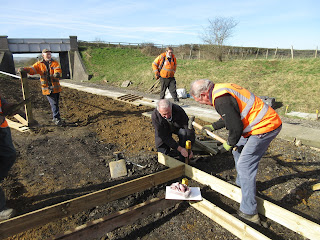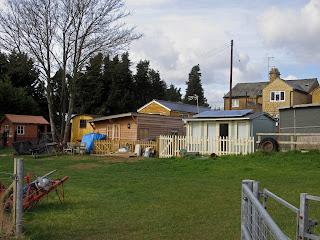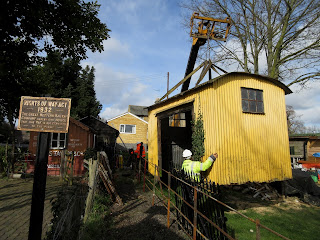Here we go then.
First thing, a committee met to muse about the shelter foundations. This can best be viewed from track level. A ring of bricks, you say? How many? Really? Well, I wouldn't start from there if I was you.
Up inside the shelter, Jim and Tim were hard at work cutting the lower edge to size (all the moth eaten bits were cut off) and working out how to reinforce the legs.
Here's the lovely straight edge that they cut.
The foreground is the old doors, which were put in at Usk, but which were not original. They now make a useful working surface.
It was decided that a bit more work was needed at Toddington, to give the corner posts some proper feet to stand on, a slight change of design from last week's ideas (keep up at the back there, no falling asleep!)
Jim and Tim (we like the name of this team) then moved on to the handrails. These need joining together, and last week's attempt at screwed on sleeves failed because we ended up with different sizes.
In order to stick with the heritage idea of sleeves to hold the pipes together, we had a rethink, and came up with this version:
The sleeves are held on with grub screws, which looks the same, and it's not the welds that were first proposed.
We were warned about a 'stock movement' and to our joy (the majority of the Hayles gang being from the PWay department) it was our mess coach and a tools van that were being brought up from Winchcombe to Toddington. Here they come!
Here it is: the PWay mess van, a Mk1 brake, converted to a kitchen and 'dining room' in which we have enjoyed many a sausage and chips, but unfortunately far from the extension 'coal face'.
It is being moved nearer, to be parked in the 'Parlour Road' at Toddington. That's the short siding by the building, formerly the cattle dock. More extension materials are also being moved up from Winchcombe to the 'coal face'. One day we would like to take the coach up to the extension whenever we work there.
Lunch was a bacon buttie, but this time with egg. It ran down your fingers, which accounts for the concentrations on the faces of these volunteers. A photograph? No time mate, it's dribbling down on my trousers....
After lunch, the shelter base!
The idea, explained last week, was to build a ring of bricks, on which the corrugated iron shelter would sit.
Here it is then, that didn't take very long. We have our ring of bricks and the shelter will sit on top of it. The corrugated iron sheets were cut a little longer, and these should project over the bricks, and make the bottom water proof from the rain. We are now ready to lift the shelter on it, once the shelter itself is ready (not yet though).
The other job today was to lay some edging to the rear of the platform. The other four volunteers started fitting the boarding at the back edge of the platform on the Winchcombe end, but very quickly realised that the infill was already much too high. The fixing stakes had to be put as it was below ground level to ensure they would be level with the platform edge. A considerable amount of fill had to be shifted before the first boards could be fitted. This got better as we worked towards the platform centre where the fill top was much lower. This group also set to work removing the weeds from the slope and regrading, removing any large stones. We must get ready for the grass seeds here.
By the end of the day the rear edging was about 60% done. Notice also the neat slope at the back. The seed for it is expected next week. A bonfire was lit to reduce the now large volume of weeds, many of which were of triffid proportions when dug out.
The last handrail post at the top was also concreted in, while we had the mixer out.
Here Paul is cuting the pipe to length to fit the last post, which was later concreted in.
When the container has been removed, we intend to place a bench at the top, so that walkers can sit down and enjoy the view of the trains.
We are aiming for a summer opening date (the actual date is being worked on, so stay in touch).
Then it's on to the next project for the Heritage Group. What will it be? Pencils are being sharpened as we write. It should be a good one, we have shown that we can do it. Especially if we have your support.
Following the making up of this post, your blogger's camera has recovered, so we should be able to show some more extension work at Broadway tomorrow evening.































































